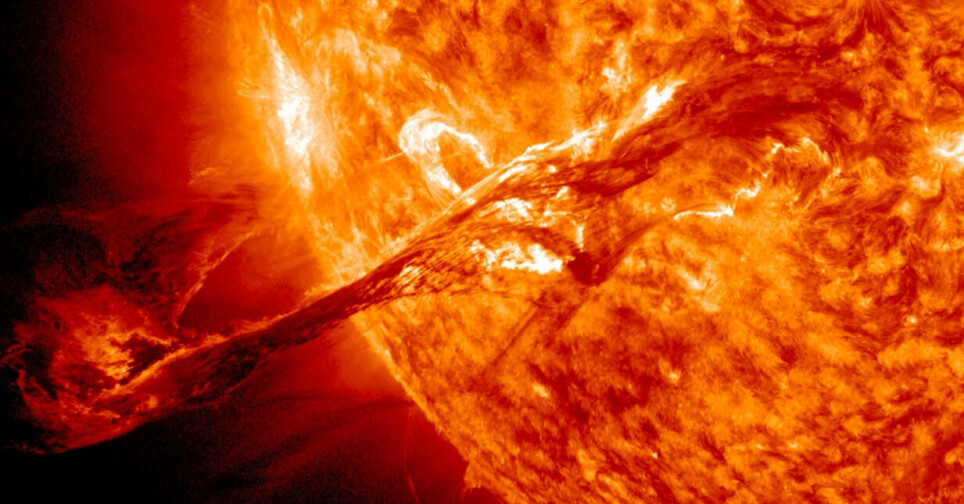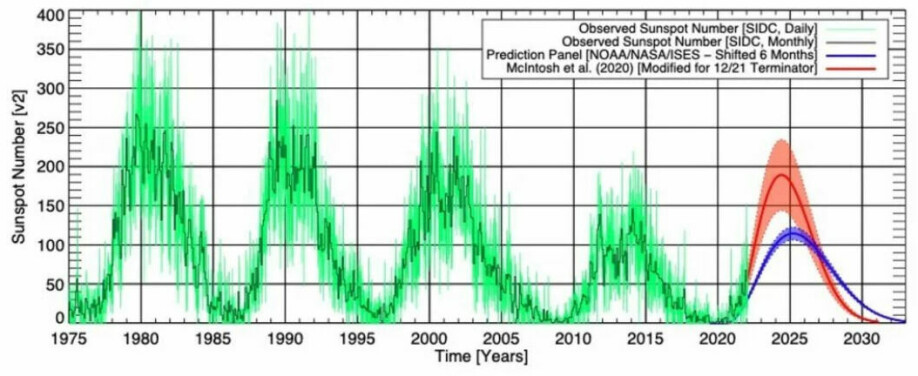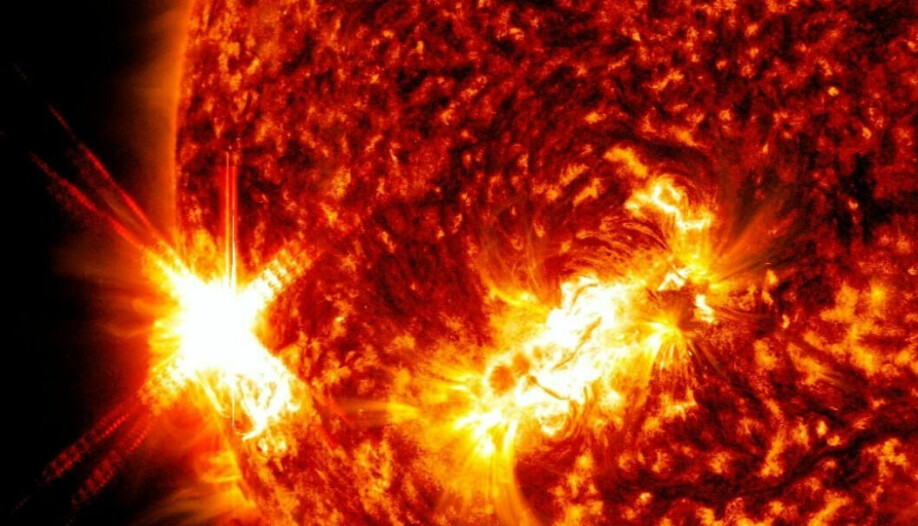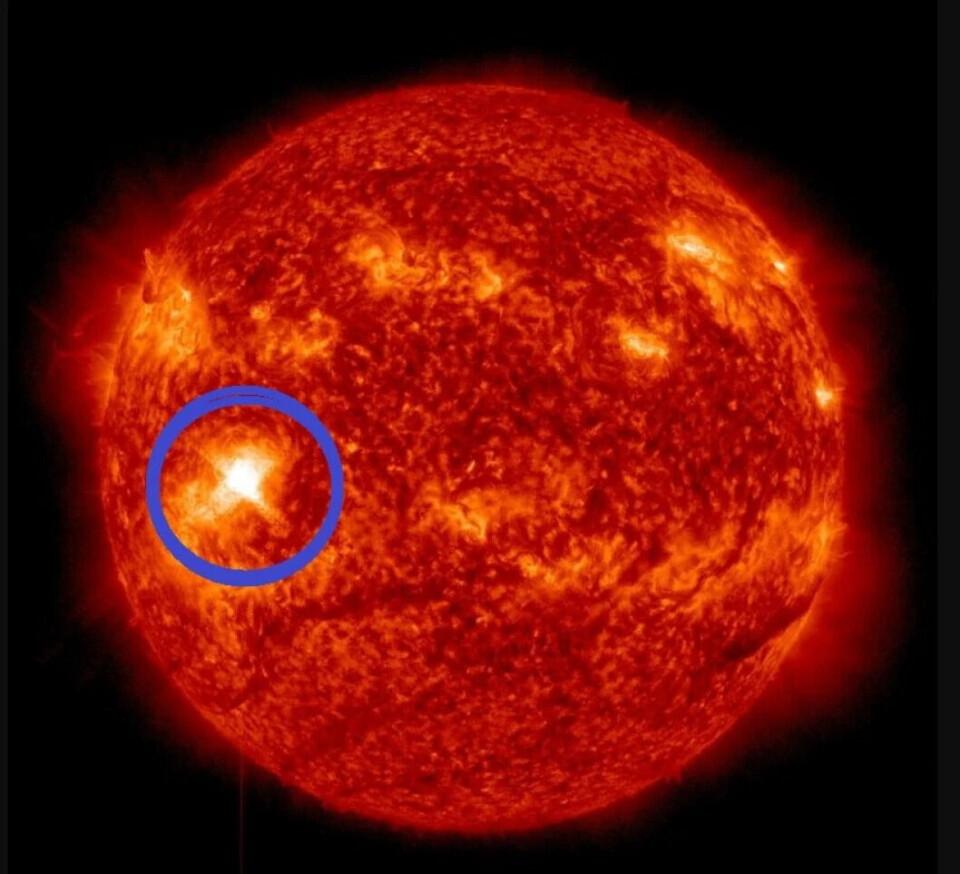
A strong solar storm will probably increase northern lights in the near future
Solar cycle 25 has proven to be far more powerful than researchers anticipated. This also increases the chances of catastrophic solar storms reaching the Earth.
Our Sun has been around for a long time. It has already existed for roughly five billion years, and will continue to exist for several billion more.
But it changes all the time, even though to our eyes the Sun seems very stable. Roughly every 11 years, the Sun goes through a solar cycle.
This is a period during which the Sun's extremely powerful magnetic field twists and turns. The Sun's magnetic north and south poles switch places during the cycle.
While this is going on, the chances of powerful eruptions on the Sun, called solar storms, increase.
Can interfere with electronics and create northern lights
These solar storms can create major disturbances for electronics, such as satellites and spacecrafts, among other things. If the solar storm is intense enough, such disturbances can also be felt on Earth. The most visible result, however, is the northern lights.
This light show in the sky occurs when charged particles from the Sun are ejected into the Earth's atmosphere and collide with air molecules far above the ground.
During the middle of the cycle, these storms reach a peak called the solar maximum. After this, the activity shifts again, and the Sun becomes quieter and quieter until the cycle is over.
Solar activity is measured by analysing the sunspots that appear on the Sun's surface. These are dark spots that indicate very intense magnetic fields that extend from the interior of the Sun.

Statistics back to the 17th century
Right now, we are a few years into cycle 25. It started at the end of 2019, and will peak in 2025.
There have been many more than 25 solar cycles, of course - the Sun is several billion years old. But we only have a reliable series of observations of sunspots back to the 17th century. These observations are used to estimate solar activity several hundred years ago.
Thus, the cycles can also be compared with each other, and a number of research groups create models that try to predict the intensity of future solar activity.
But getting the right prediction is difficult. Solar cycle 25 is currently much more powerful than the models would suggest. This has been confirmed by NASA and NOAA, among other experts.

Expected a quiet solar cycle
“We don’t understand the solar cycle well enough to make good predictions,” says solar researcher Mats Carlsson. He is a professor at the Rosseland Centre for Solar Physics at the University of Oslo (UiO).
His colleagues there aren’t actually working on developing calculations to estimate solar cycle intensities, but instead have ongoing projects to create computer models of the Sun.
Carlsson says that there is a very large spread in forecasts from research groups working internationally on predicting solar cycles.
The last cycles have been historically weak, after a very active Sun with many eruptions and high sunspot numbers in the 1950s. After that, the Sun has generally had quieter cycles.
Researchers also expected the last solar cycle to be calm.
“Cycles 23 and 24 were increasingly less active,” Carlsson said.
Data from previous cycles help predict new solar cycles, much like previous weather events help shape future weather forecasts. So it is perhaps not so strange that the researchers thought the new cycle would be calm, Carlsson said.
“But now we can see that it is already more powerful than the previous one,” he said.

Perhaps the most powerful in 20 years
A more active solar cycle means a greater probability of eruptions on the Sun. This could mean more northern lights in our skies, but also a greater likelihood of devastating solar storms.
The new solar cycle may be the most powerful since a peak about 20 years ago.
Carlsson thinks we could possibly reach that 20 year peak during the current solar cycle.
Researchers have already recorded a number of powerful eruptions on the Sun. These eruptions travel in different directions away from the Sun. But whether or not they strike the Earth is random.
In 2021, for example, a warning was issued for a powerful solar flare that could strike the Earth and result in disturbances or disruptions in electronics. Northern lights were predicted to be visible as far south as Germany.
In October 2022, it was possible to see the northern lights as far south as Oslo, according to VG (link in Norwegian), a Norwegian national newspaper.
Earth was struck in 1859
The Earth has previously been struck by powerful solar eruptions. The most famous was in 1859, but at that time, electricity was not widely used, so it didn't matter much. In recent times, solar storms have caused major power outages. On 13 March 1989 a solar storm caused a power outage in the entire province of Québec in Canada.
This is one of the reasons why it is important to understand how the Sun works, so that researchers can make sound predictions about what to expect.
But there is hope that researchers will soon be able to predict the solar cycle better, Carlsson said.
Difficult simulations
To understand the Sun, scientists must create computer models that are as similar to the real Sun as possible.
One challenge has been to recreate some of what drives the entire solar cycle, namely that the Sun rotates differently at the equator than at the poles. The Sun is not a solid sphere, but more like a ball of liquid.
It rotates faster at its equator than at the poles. This helps to twist and turn the magnetic fields.
But researchers have found it difficult to get their simulations to incorporate these properties. In many simulations, the Sun has behaved opposite to the way it actually does. It has rotated faster at the poles than at the equator, Carlsson said.

A better simulation
Recently, a Japanese research group showed that they were able to create a simulation where the Sun behaves more like it does in reality. This research has been published in the journal Nature Astronomy. These simulations have a higher resolution, the result of more powerful computers.
Mats Carlsson believes this shows how modelling the Sun is headed in the right direction, which in turn can provide a better understanding of what is happening.
Now we just have to wait for the solar activity to pick up as we come closer to 2025. If the rest of the cycle goes as expected, the current cycle will last until around 2030.
Translated by Nancy Bazilchuk
———
Read the Norwegian version of this article on forskning.no




































